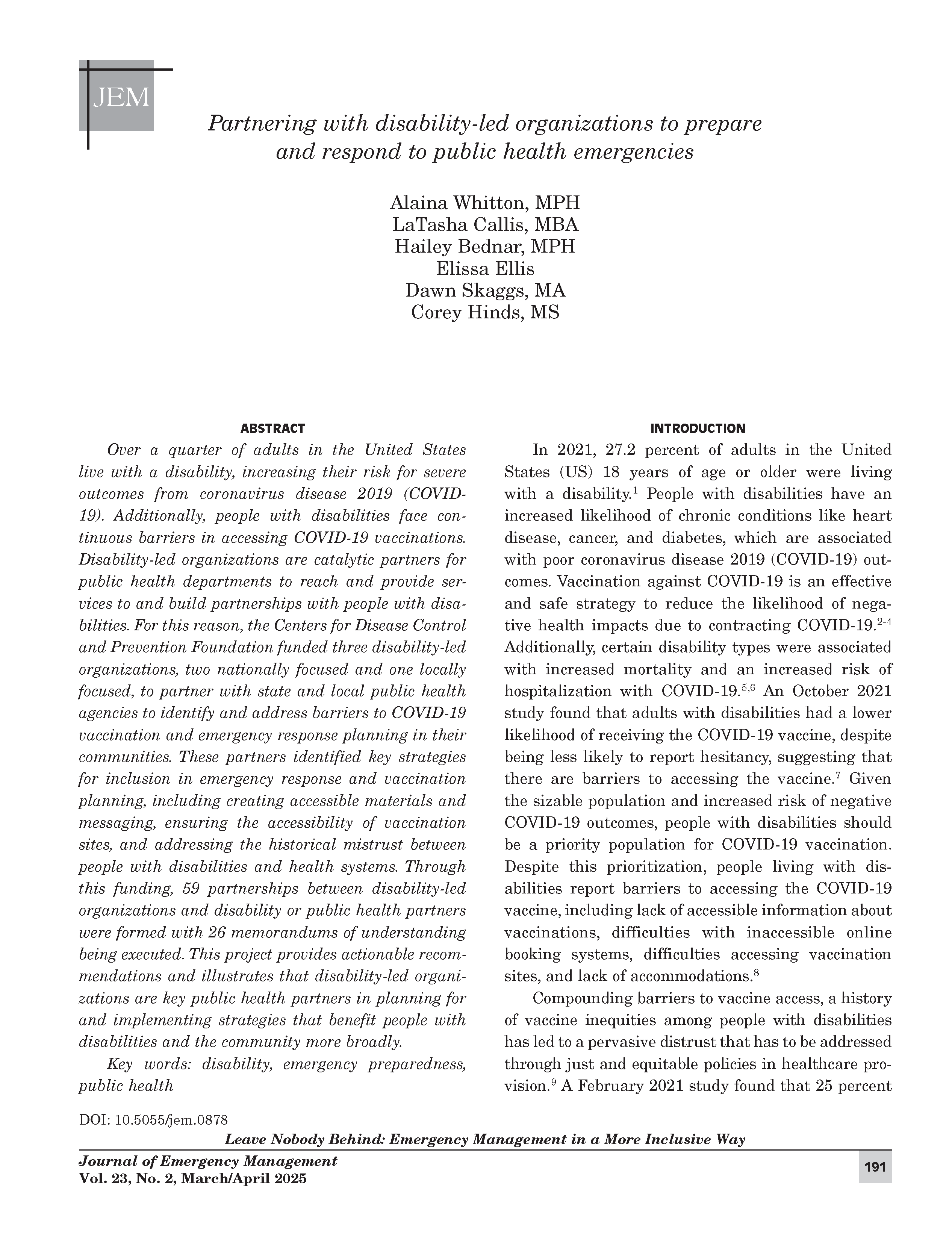Partnering with disability-led organizations to prepare and respond to public health emergencies
DOI:
https://doi.org/10.5055/jem.0878Keywords:
disability, emergency preparedness, public healthAbstract
Over a quarter of adults in the United States live with a disability, increasing their risk for severe outcomes from coronavirus disease 2019 (COVID-19). Additionally, people with disabilities face continuous barriers in accessing COVID-19 vaccinations. Disability-led organizations are catalytic partners for public health departments to reach and provide services to and build partnerships with people with disabilities. For this reason, the Centers for Disease Control and Prevention Foundation funded three disability-led organizations, two nationally focused and one locally focused, to partner with state and local public health agencies to identify and address barriers to COVID-19 vaccination and emergency response planning in their communities. These partners identified key strategies for inclusion in emergency response and vaccination planning, including creating accessible materials and messaging, ensuring the accessibility of vaccination sites, and addressing the historical mistrust between people with disabilities and health systems. Through this funding, 59 partnerships between disability-led organizations and disability or public health partners were formed with 26 memorandums of understanding being executed. This project provides actionable recommendations and illustrates that disability-led organizations are key public health partners in planning for and implementing strategies that benefit people with disabilities and the community more broadly.
References
Centers for Disease Control and Prevention (CDC): Disability and health data system (DHDS). 2022. Available at https://www.cdc.gov/ncbddd/disabilityandhealth/dhds/index.html. Accessed January 31, 2023.
Hause AM: Safety monitoring of bivalent COVID-19 mRNA vaccine booster doses among persons aged ≥12 years—United States, August 31–October 23, 2022. MMWR Morb Mortal Wkly Rep. 2022; 71: 1401-1406. DOI: 10.15585/mmwr.mm7144a3.
Dixon-Ibarra A: Disability status as an antecedent to chronic conditions: National Health Interview Survey, 2006–2012. Prev Chronic Dis. 2014; 11. DOI: 10.5888/pcd11.130251.
Hacker KA: COVID-19 and chronic disease: The impact now and in the future. Prev Chronic Dis. 2021; 18. DOI: 10.5888/pcd18.210086.
Ryerson AB, Yeargin-Allsopp M, Clark KEN, et al.: Brief summary of findings on the association between disabilities and severe COVID-19 outcomes.
Clarke KEN, Hong K, Schoonveld M, et al.: Severity of coronavirus disease 2019 hospitalization outcomes and patient disposition differ by disability status and disability type. Clin Infect Dis. 2023; 76(5): 871-880. DOI: 10.1093/cid/ciac826.
Ryerson AB: Disparities in COVID-19 vaccination status, intent, and perceived access for noninstitutionalized adults, by disability status—National Immunization Survey Adult COVID Module, United States, May 30–June 26, 2021. MMWR Morb Mortal Wkly Rep. 2021; 70: 1365-1371. DOI: 10.15585/mmwr.mm7039a2.
Sebring JCH, Capurro G, Kelly C, et al.: “None of it was especially easy”: Improving COVID-19 vaccine equity for people with disabilities. Can J Public Health. 2022; 113(6): 887-897. DOI: 10.17269/s41997-022-00621-z.
WHO: Health inequity and the effects of COVID-19: Assessing, responding to and mitigating the socioeconomic impact on health to build a better future. 2020. Available at https://apps.who.int/iris/bitstream/handle/10665/338199/WHO-EURO-2020-1744-41495-56594-eng.pdf. Accessed August 27, 2024.
Myers A, Ipsen C, Lissau A: COVID-19 vaccination hesitancy among Americans with disabilities aged 18-65: An exploratory analysis. Disabil Health J. 2022; 15(1): 101223. DOI: 10.1016/j.dhjo.2021.101223.
Ipsen C, Myers A, Sage R: A cross-sectional analysis of trust of information and COVID-19 preventative practices among people with disabilities. Disabil Health J. 2021; 14(2): 101062. DOI: 10.1016/j.dhjo.2021.101062.
Truong J, Bakshi S, Wasim A, et al.: What factors promote vaccine hesitancy or acceptance during pandemics? A systematic review and thematic analysis. Health Promot Int. 2022; 37(1): daab105. DOI: 10.1093/heapro/daab105.
Kaufman J, Bagot KL, Tuckerman J, et al.: Qualitative exploration of intentions, concerns and information needs of vaccine-hesitant adults initially prioritised to receive COVID-19 vaccines in Australia. Aust N Z J Public Health. 2022; 46(1): 16-24. DOI: 10.1111/1753-6405.13184.
Kerr JR, Freeman ALJ, Marteau TM, et al.: Effect of information about COVID-19 vaccine effectiveness and side effects on behavioural intentions: Two online experiments. Vaccines (Basel). 2021; 9(4): 379. DOI: 10.3390/vaccines9040379.
SAGE Working Group: Report of the SAGE Working Group on Vaccine Hesitancy. Thousand Oaks, CA: SAGE Working Group, 2014.
ACL: Strategies for helping older adults and people with disabilities access COVID-19 vaccines. 2021.
UN News: Preventing discrimination against people with disabilities in COVID-19 response. 2020. Available at https://news.un.org/en/story/2020/03/1059762. Accessed January 31, 2023.
CDC: Ensuring equitable COVID-19 vaccine access for older adults and people with disabilities. 2022. Available at https://www.cdc.gov/vaccines/covid-19/clinical-considerations/older-adults-anddisability/access.html. Accessed January 31, 2023.
US EEOC: The Rehabilitation Act of 1973. Available at https://www.eeoc.gov/statutes/rehabilitation-act-1973. Accessed August 14, 2023.
ADA.gov: Americans with Disabilities Act of 1990. As amended. Available at https://www.ada.gov/law-and-regs/ada/. Accessed August 14, 2023.
National Council on Independent Living: About independent living. 2012. Available at https://ncil.org/about/aboutil/. Accessed August 14, 2023.
ACL: Centers for independent living. Available at https://acl.gov/programs/aging-and-disability-networks/centers-independentliving. Accessed February 6, 2023.
Armitage R, Nellums LB: The COVID-19 response must be disability inclusive. Lancet Public Health. 2020; 5(5): e257. DOI: 10.1016/S2468-2667(20)30076-1.
Jo G, Habib D, Varadaraj V, et al.: COVID-19 vaccine website accessibility dashboard. Disabil Health J. 2022; 15(3): 101325. DOI: 10.1016/j.dhjo.2022.101325.
NACCHO: 2020 forces of change: The COVID-19 edition. 2020. Available at https://www.naccho.org/uploads/downloadable-resources/2020-Forces-of-Change-The-COVID-19-Edition.pdf. Accessed August 27, 2024.
Web Accessibility Initiative (WAI): W3C accessibility standards overview. Available at https://www.w3.org/WAI/standards-guidelines/. Accessed January 25, 2024.
Alismail S, Chipidza W: Accessibility evaluation of COVID-19 vaccine registration websites across the United States. J Am Med Inform Assoc. 2021; 28(9): 1990-1995. DOI: 10.1093/jamia/ocab105.
Howe JL, Young CR, Parau CA, et al.: Accessibility and usability of state health department COVID-19 vaccine websites: A qualitative study. JAMA Netw Open. 2021; 4(5): e2114861. DOI: 10.1001/jamanetworkopen.2021.14861.
Bagasra AB, Doan S, Allen CT: Racial differences in institutional trust and COVID-19 vaccine hesitancy and refusal. BMC Public Health. 2021; 21(1): 2104. DOI: 10.1186/s12889-021-12195-5.

Downloads
Published
How to Cite
Issue
Section
License
Copyright 2007-2025, Weston Medical Publishing, LLC and Journal of Emergency Management. All Rights Reserved.





